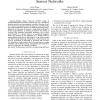Free Online Productivity Tools
i2Speak
i2Symbol
i2OCR
iTex2Img
iWeb2Print
iWeb2Shot
i2Type
iPdf2Split
iPdf2Merge
i2Bopomofo
i2Arabic
i2Style
i2Image
i2PDF
iLatex2Rtf
Sci2ools
GLOBECOM
2008
IEEE
2008
IEEE
Mesh-Based Coverage for Wireless Sensor Networks
—Wireless Sensor Networks (WSNs) consist of spatially-distributed autonomous sensors that can cooperatively monitor physical and environmental conditions. Because of sensors’ resource-constraints in terms of size, power, and bandwidth, one of the fundamental objectives in WSNs is improving energyefficiency. In this paper, we propose a mesh-based technique to obtain energy-efficiency in sensing and improve the quality of coverage. Our technique dynamically schedules a set of active sensors based on a square mesh or an equilateral-triangular mesh. The purpose of our technique is to quickly build an energy-efficient mesh that is self-adaptive to the local topology and allows energy balancing. Furthermore, a hole detection and recovery mechanism is discussed to guarantee full coverage. The simulation results confirm that our mesh-based coverage technique reduces sensing energy consumption and maintains a sound coverage ratio for reliable surveillance. Key words: wireless sensor net...
GLOBECOM 2008 | Sensor Networks | Spatially-distributed Autonomous Sensors | Telecommunications | —wireless Sensor Networks |
| Added | 29 May 2010 |
| Updated | 29 May 2010 |
| Type | Conference |
| Year | 2008 |
| Where | GLOBECOM |
| Authors | Jiong Wang, Sirisha Medidi |
Comments (0)

